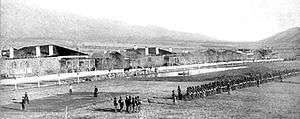Fort Grant, Arizona
| Fort Grant | |
|---|---|
| Aravaipa Canyon, Arizona | |
|
Fort Grant, c.1885. | |
| Type | Army fortification |
| Site information | |
| Controlled by |
|
| Condition | tourist attraction |
| Site history | |
| Built | 1872 |
| Built by |
|
| In use | 1860–1905 |
| Battles/wars | Apache Wars |
| Garrison information | |
| Occupants |
|
Fort Grant, located in the U.S. state of Arizona, is a state prison and a former United States Army fortification. Fort Grant is located on the southwestern slope of Mount Graham in what is now Graham County. The post is named for Ulysses S. Grant, 18th President of the United States.[1]
History

Fort Grant began its life as Camp Grant, Arizona (formerly Fort Breckinridge in August 1860 as an Old West outpost in Arizona Territory, at the junction of Aravaipa Creek and the San Pedro River. Fort Breckinridge was destroyed and the site abandoned in 1861, following removal of the Union garrison at the start of the American Civil War.
The site of Fort Breckinridge was reoccupied as Fort Stanford, or Camp Stanford, from 1862 to 1865 by troops of the California Column. When the U. S. Army reoccupied the site it was renamed Camp Grant, from 1865 to 1872.
In 1872 after the Camp Grant Massacre, the United States Army post at "old" Camp Grant, at the confluence of Aravaipa Creek and the San Pedro River, was relocated to the southwestern slope of Graham Mountain in what is now Graham County. The new fort was strategically placed so as to protect settlers who were constantly harassed by Apache warriors. It played a prominent role in the Apache Wars of the 1880s. It was repurposed in 1900 as a staging point for soldiers going to the Philippines to fight in the Philippine–American War.
Henry McCarty or (McCarthy), William Antrim, Henry Antrim, William McCarty, William Bonney, and William H. Bonney, or better known as, "Billy the Kid," reportedly settled in the vicinity of Fort Grant in 1876 working as a ranch hand and tending sheep nearby. In 1877 McCarty killed a local blacksmith at a saloon and gambling house that is now called the Bonita Store, located a few miles from Fort Grant. McCarty was taken into custody at the Fort Grant stockade, but escaped to New Mexico before he could be tried.
Edgar Rice Burroughs was stationed at Fort Grant in 1896 as an enlisted man after failing the exam for entrance to West Point. He was discharged in 1897 after being diagnosed with a heart condition that made him ineligible for a commission.
Fort Grant was abandoned in 1905 by the Army, which transferred all troops to Fort Huachuca and left the fort unoccupied except for a caretaker. In 1912, Arizona gained statehood, and the fort was occupied by the State Industrial School for Wayward Boys and Girls, which modernized most of the buildings.[2][3]
In 1968, the state of Arizona officially assigned the site to the Department of Corrections, and in 1973 Fort Grant became a state prison for male convicts. In 1997 the prison became a unit of an Arizona State Prison complex headquartered in Safford.
The main road to and from Fort Grant is Arizona State Route 266. There is an abandoned general-aviation airport, Angel Field, immediately south of the prison.
Fort Grant Historical Museum
The Fort Grant Historical Museum is located in the lobby of the administration building, which is outside the prison grounds. The museum features artifacts and photos about the fort's military history up through its history as a state reformatory and later as a state prison.[4]
UPDATE:
Fort Grant no longer has a visitor area or museum.
Visitors are not allowed on prison property unless it is to visit an incarcerated inmate.
The administration building has been closed and has no known plans to reopen.
See also
Climate
According to the Köppen Climate Classification system, Fort Grant has a semi-arid climate, abbreviated "BSk" on climate maps.[5]
References
- ↑ Gannett, Henry (1905). The Origin of Certain Place Names in the United States. Govt. Print. Off. p. 141.
- ↑ "Fort Grant History". Arizona Department of Corrections. Retrieved December 8, 2011.
- ↑ A pictorial tour of the Arizona State Industrial School for Boys at Fort Grant, Arizona. Print Shop. 1949.
- ↑ "Museum/Heritage Resources". Graham County Chamber of Commerce. Retrieved 1 December 2013.
- ↑ Climate Summary for Fort Grant, Arizona
- Historic Forts
- Fort Grant History (Arizona Department of Corrections)
- Angel Field, Fort Grant, AZ
- Aerial View, Google Maps
External links
- Fort Grant Historical Museum - visiting information
Coordinates: 32°37′22″N 109°56′45″W / 32.62278°N 109.94583°W

